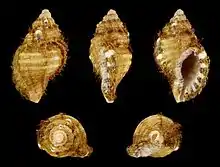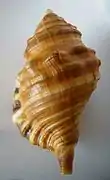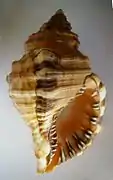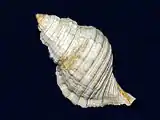Monoplex parthenopeus
Monoplex parthenopeus,[3][4] common name the giant triton or giant hairy triton, is a species of sea snail, a marine gastropod mollusk in the family Cymatiidae.[2] It preys on other molluscs.
| Monoplex parthenopeus | |
|---|---|
 | |
| Apertural view of Monoplex parthenopeus | |
| Scientific classification | |
| Kingdom: | Animalia |
| Phylum: | Mollusca |
| Class: | Gastropoda |
| Subclass: | Caenogastropoda |
| Order: | Littorinimorpha |
| Family: | Cymatiidae |
| Genus: | Monoplex |
| Species: | M. parthenopeus |
| Binomial name | |
| Monoplex parthenopeus (Salis-Marschlins, 1793) | |
| Synonyms[2] | |
| |
Fossil records
This species have been recorded as fossils from the Miocene to the Quaternary (from 15.97 to 0.0 million years ago).[5]
Life cycle
Hairy tritons are notable for having particularly long planktonic periods. The veliger larvae remain in the plankton for nearly 300 days, dispersing as far as 4000 km.[8] This is the longest known larval duration and dispersal distance of any marine invertebrate which occurs along the west coast of North America.[9]
Gallery
 A shell of Monoplex parthenopeus with periostracum removed
A shell of Monoplex parthenopeus with periostracum removed Same shell, apertural view
Same shell, apertural view.jpg.webp) Apertural view of Monoplex parthenopeus echo (Kuroda & Habe in Kira, 1961) with operculum and periostracum attached
Apertural view of Monoplex parthenopeus echo (Kuroda & Habe in Kira, 1961) with operculum and periostracum attached Fossil shell of Monoplex parthenopeus from Pliocene of Italy
Fossil shell of Monoplex parthenopeus from Pliocene of Italy
References
- Mollusc Specialist Group (2000). "Cymatium parthenopaeum". IUCN Red List of Threatened Species. 2000: e.T6069A12386021. doi:10.2305/IUCN.UK.2000.RLTS.T6069A12386021.en.
- Monoplex parthenopeus (Salis-Marschlins, 1793). Retrieved through: World Register of Marine Species on 6 December 2018.
- "Cymatium parthenopeum (Salis, 1793)", CLEMAM, accessed 18 February 2011.
- "Cymatium parthenopeum (von Salis, 1793)". Malacolog Version 4.1.1. A Database of Western Atlantic Marine Mollusca. accessed 17 February 2011.
- Fossilworks
- Powell A. W. B., New Zealand Mollusca, William Collins Publishers Ltd, Auckland, New Zealand 1979 ISBN 0-00-216906-1
- Welch J. J. (2010). "The "Island Rule" and Deep-Sea Gastropods: Re-Examining the Evidence". PLOS One 5(1): e8776. doi:10.1371/journal.pone.0008776.
- Scheltema, R. S. 1971. Larval dispersal as a means of genetic exchange between geographically separated populations of shoalwater benthic marine gastropods. Biological Bulletin 140:284–322.
- AL Shanks, BA Grantham, MH Carr (2003) Propagule dispersal distance and the size and spacing of marine reserves. Ecological Applications, 13, S159-S169.
- Gofas, S.; Afonso, J.P.; Brandào, M. (Ed.). (S.a.). Conchas e Moluscos de Angola = Coquillages et Mollusques d'Angola. [Shells and molluscs of Angola]. Universidade Agostinho / Elf Aquitaine Angola: Angola. 140 pp
- Gofas, S.; Le Renard, J.; Bouchet, P. (2001). Mollusca, in: Costello, M.J. et al. (Ed.) (2001). European register of marine species: a check-list of the marine species in Europe and a bibliography of guides to their identification. Collection Patrimoines Naturels, 50: pp. 180–213
- Rolán E., 2005. Malacological Fauna From The Cape Verde Archipelago. Part 1, Polyplacophora and Gastropoda.
- Rosenberg, G., F. Moretzsohn, and E. F. García. 2009. Gastropoda (Mollusca) of the Gulf of Mexico, Pp. 579–699 in Felder, D.L. and D.K. Camp (eds.), Gulf of Mexico–Origins, Waters, and Biota. Biodiversity. Texas A&M Press, College Station, Texas
External links
| Wikimedia Commons has media related to Monoplex parthenopeus. |
- Drawing of the shell
- Photos of Monoplex parthenopeus on Sealife Collection
This article is issued from Wikipedia. The text is licensed under Creative Commons - Attribution - Sharealike. Additional terms may apply for the media files.
